Why have batteries become important?
In a world increasingly anxious about climate change, the surge in the generation of renewable energy over the past 20 years offers a sliver of hope. But the variable nature of wind and solar power means that storing energy until consumers need it has become the next big challenge. And so, large-scale battery installations are springing up across electricity grids around the world, to make them more flexible. In 2017, more than 1GW of energy storage capacity was added around the world – a record, yes, but still a drop in the ocean of global energy demand.
How do batteries like this work?
Of course, we are not talking about a few AAA batteries here. And yet, all batteries broadly work in a similar manner.
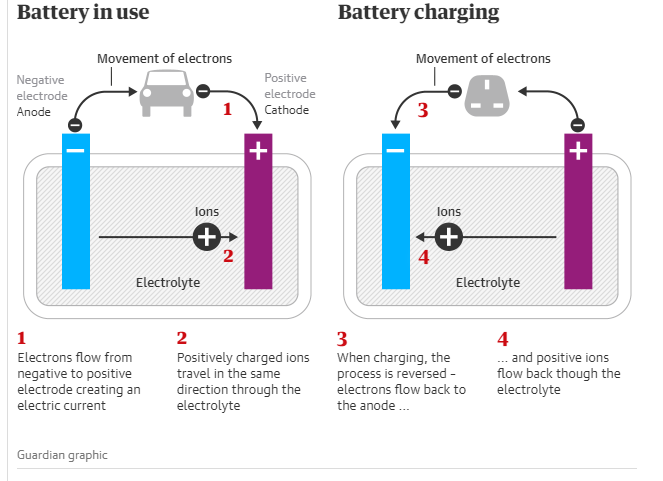
Electrical energy is converted to chemical energy when you charge a battery, and then the process is reversed when you draw power from it.
There are three main constituents of most batteries: two electrodes and some form of chemical medium called the electrolyte, which can be a liquid, gel or solid. To generate electricity, a chemical reaction takes place that sees electrons move from the negative electrode, called the anode, to the positive electrode, called the cathode.Advertisement
When you charge the battery, the process is reversed, sending electrons back to the anode.
So how many of these big batteries are there?
There is around 500MW of large-scale battery capacity installed around the UK, a figure that is expected to double within three years, according to the analysts Aurora Energy Research. Almost all capacity uses lithium-ion.
Globally installed capacity is expected to top 50GW by 2020 – and surge to almost 1,000GW by 2040, according to Bloomberg NEF. That would equate to about 7% of the world’s energy capacity.
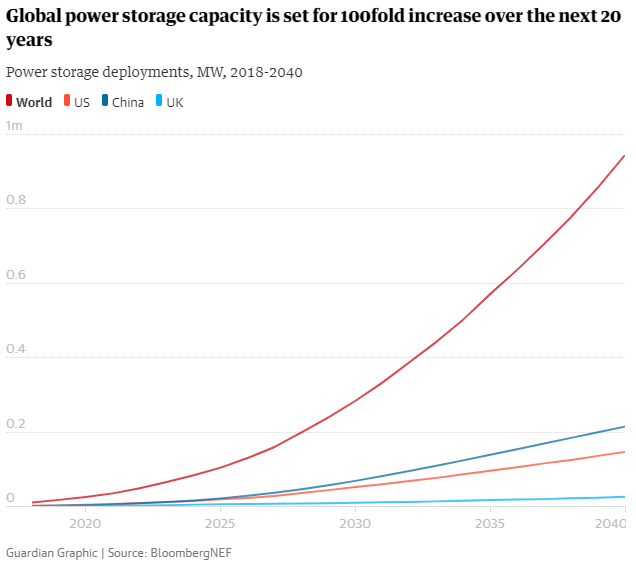
How do batteries fit in to the renewables revolution?
In the UK, battery installations are primarily being deployed to supply services to National Grid. Such ancillary services are increasingly important to help match supply and demand as a growing amount of intermittent wind and solar power comes online.
There are also the beginnings of “hybrid” renewable energy power plants, where batteries are installed alongside solar farms and windfarms. This is particularly important for the economics of solar farms, which can push down power prices around midday by peaking at the same time. Instead of exporting immediately, hybrid farms can store power to sell later at higher prices.
In other parts of the world, such as South Australia, batteries are being usedto make the grid more resilient and avoid blackouts. Crucially, batteries are not yet suitable and do not make economic sense for interseasonal storage – that is, storing up solar power in summer to release in winter.
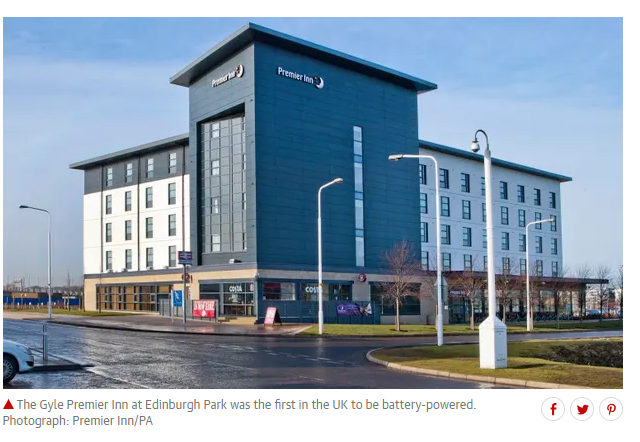
Will we all have big household batteries in the future?
Elon Musk may have popularised the concept of a home battery when he unveiled Tesla’s version three years ago, but the firm was not the first and is not the biggest in this field. Such batteries, which are about the size of a gas boiler, can store and release electricity either generated by a household or imported from the grid.
The German firm Sonnen, which has around a 25% global market share in home batteries, said most customers today are people who have solar panels or live in storm-hit regions and want a clean, reliable backup source of power. “The market is still in the very, very early phase,” says the chief executive, Christoph Ostermann. Germany, Italy, Australia and the US states of California and Hawaii are the biggest markets so far.
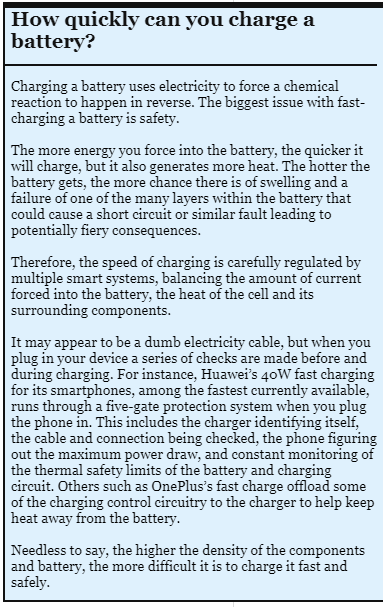
For solar households, it makes more financial sense to store and consume the energy rather than be paid for exporting it to the grid. In future, as more time-of-use energy tariffs emerge, there might also be enough of an incentive to install one to avoid peak pricing.Advertisement
However, for Ostermann, the most exciting prospect is harnessing thousands of the batteries as a “virtual power plant”. He describes this as an “Uberisation” of batteries that the company does not own but can call on, with permission. “We are not heading for utility scale, but virtual power plants can provide significant power,” he says.
What’s next for electric cars?
We are just beginning to see the second generation of battery-powered vehicles, according to the entrepreneur Henrik Fisker, the founder of the electric car maker Fisker Automotive. He views affordability and a decent range between charges as this crop’s defining features.
While the first models, with the exception of Tesla, could manage around 100 miles, most new ones now offer between 200-300 miles. “I see the market starting to boom around 2020 or 2021, as there is more choice [of models],” says Fisker.
Fisker also views ultrafast charging as vital to helping electric cars go mainstream. While a typical home will take about 8-10 hours to fully top up a car (with a 3KW socket), some new public chargers can do that in about 10 minutes (using a 350KW charger).
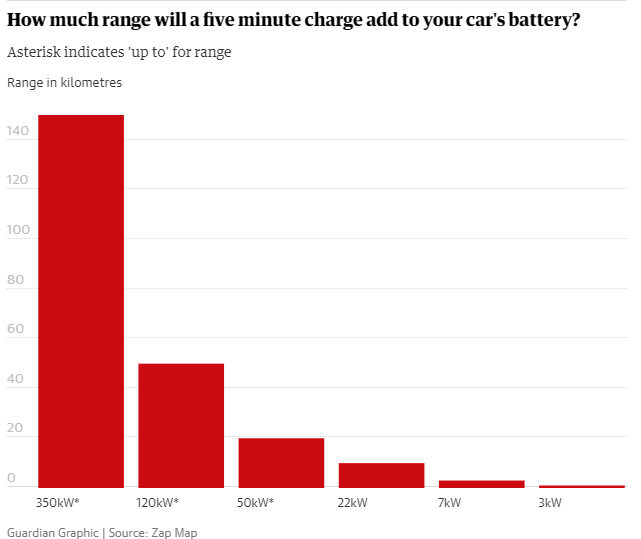
What about other modes of transport?
Electric double-decker buses, built by the Chinese manufacturer BYD, already ply the streets of London. Elon Musk has announced plans for an electric truck.
But the energy density required for heavy transport makes it a lot harder for batteries to beat fossil fuels. “It’s definitely more challenging,” says Prof Paul Shearing, the Royal Academy of Engineering’s chair in emerging battery technologies. “[But] I think the future is going to be electric, no matter which way you cut it.”
Will we all be flying around in electric jumbo jets soon? “Not yet,” says Shearing, who adds that energy density and weight of batteries meant there would probably only be used in unmanned aerial vehicles in the short term. “I think it’ll be a long time until we see an electric passenger plane,” he says.
What is the environmental and social impact of making batteries?
A key element in lithium-ion batteries is cobalt, despite manufacturers’ attempt to reduce the amount required. More than 60% world’s cobalt is produced in the Democratic Republic of Congo, where concerns have been raised about the social and environmental impact of mining the metal.
The lithium in the batteries comes mainly from three big producer countries, Australia, Argentina and Chile, along with emerging producers such as Bolivia, Brazil, Canada and Zimbabwe. Water consumption and scarcity in some producer countries is the big concern here. “There are definite ethics issues. Large companies are going to be driven by cost,” says Shearing, of cobalt and lithium production.
What happens to the batteries towards the end of their life is also a big challenge. Dr Jonathan Radcliffe, of the school of chemical engineering at the University of Birmingham, is worried about the fate of batteries when their performance in today’s crop of electric vehicles is no longer good enough for cars. Some now have a second life as a home battery, but he fears the market could be saturated in a few years, undermining the financial case for reuse.
“The risk is that there is no viable second-use in the UK and we have a large amount of battery waste, without the processes in place to deal with it,” he says.
What limits capacity and battery life?
The bigger and denser the battery, the more chemical energy it can store and therefore the more electricity it can generate. But a bigger, denser battery is more expensive, heavier, takes longer to charge and has more potential for destruction if things go wrong.
The chemistry and internal construction of the battery also plays a role in how much energy it can store. Lithium-based batteries are popular because they have a relatively high energy-to-weight ratio and maintain their charge well when not in use.
In most devices, battery life is a trade-off between physical size, design, energy density and safety, alongside the energy efficiency of the device it powers.

What about phone batteries – why do they deteriorate as they get old?
Most batteries can only maintain their full capacity for a finite time and number of charge and discharge cycles. The exact process of battery ageing is still a hot research topic, but there are several mechanisms at play that occur when the battery is used or stored.
The most common is the build-up of material on the anode, which slowly gets deposited when the battery is used or stored. A similar oxidation can also occur on the cathode, while the active ingredients of the battery can react and degrade over time. A combination of these effects reduce the amount of lithium ions and active material available for storing electricity, therefore reducing maximum capacity.
But the internal resistance of the battery can also increase as it ages, meaning its peak power output is lower, a process that causes issues in iPhones.
What accelerates battery ageing?
How a battery is used and stored can dramatically affect its ageing. For instance, batteries can be damaged by exposing them to extremes of temperature, which is more problematic for a car or similar than a smartphone.
Rapid cycling of the battery also increases wear, particularly if the power demands on the battery are very high, as is the case with electric cars. Charging and using the battery to its extremes also accelerates ageing, such as charging batteries to their maximum and discharging them to zero.
What happens when things go wrong?
Safety was thrown into the spotlight when some of the batteries inside the Samsung Galaxy Note 7 developed a fault that caused them to short circuit and catch fire.

When something disrupts the chemical reaction inside the battery, it can cause “thermal runaway”, where uncontrolled reactions chain together, generating too much heat, typically resulting in batteries bursting or catching fire.
Various safety mechanisms, both electrical control circuits and physical measures including shielding and battery structure, mean such events are rare. But they are of particular concern for portable devices, which are often held on a person, and electric vehicles that may be involved in a collision that could damage the integrity of the battery.
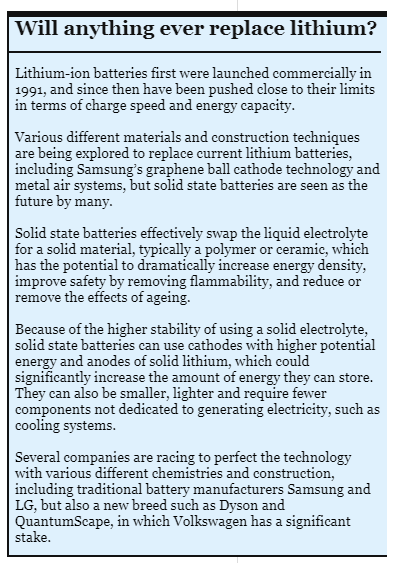
What next?
Companies are working hard to increase the amount of energy that can be packed into a battery, and to bring down the cost of making them.
Future prices are unlikely to fall as fast as they have in the past, says Ostermann, because reductions have already been so rapid. Sonnen has seen prices fall from more than €1,000 (£905) per kilowatt hour of capacity when it started in 2010, to about €150-200 per kWh today. But the company expects to cut costs in electronics such as inverters.
New wonder materials will take a while to break through, Shearing says. “The next 10 years are going to continue to be lithium-ion dominated. It’s taken a long time to get to this productivity and technological maturity level. For anything to catch up will take a while.”
Most innovation will be around lithium-ion, he believes, such as improving the energy density and lowering costs by reducing the amount of cobalt in a battery. The rate at which batteries can take on a charge will also improve, Shearing adds.
Radcliffe agrees that lithium-ion will continue to dominate. Cost and performance will improve, driven by the scale-up of manufacturing and continued research, he says.
Batteries will also be put to new uses. Fisker says that as technology improves, he expects to see them eventually appear on construction sites, in mines and in industrial equipment, replacing diesel generators. They will be deployed in increasingly small devices, such as medical implants, Shearing says.
Source: https://www.theguardian.com/news/2019/jan/14/on-the-charge-why-batteries-are-the-future-of-clean-energy
If you want to know more, Please contact me with: collin@newarebattery.com
Comments are closed.






